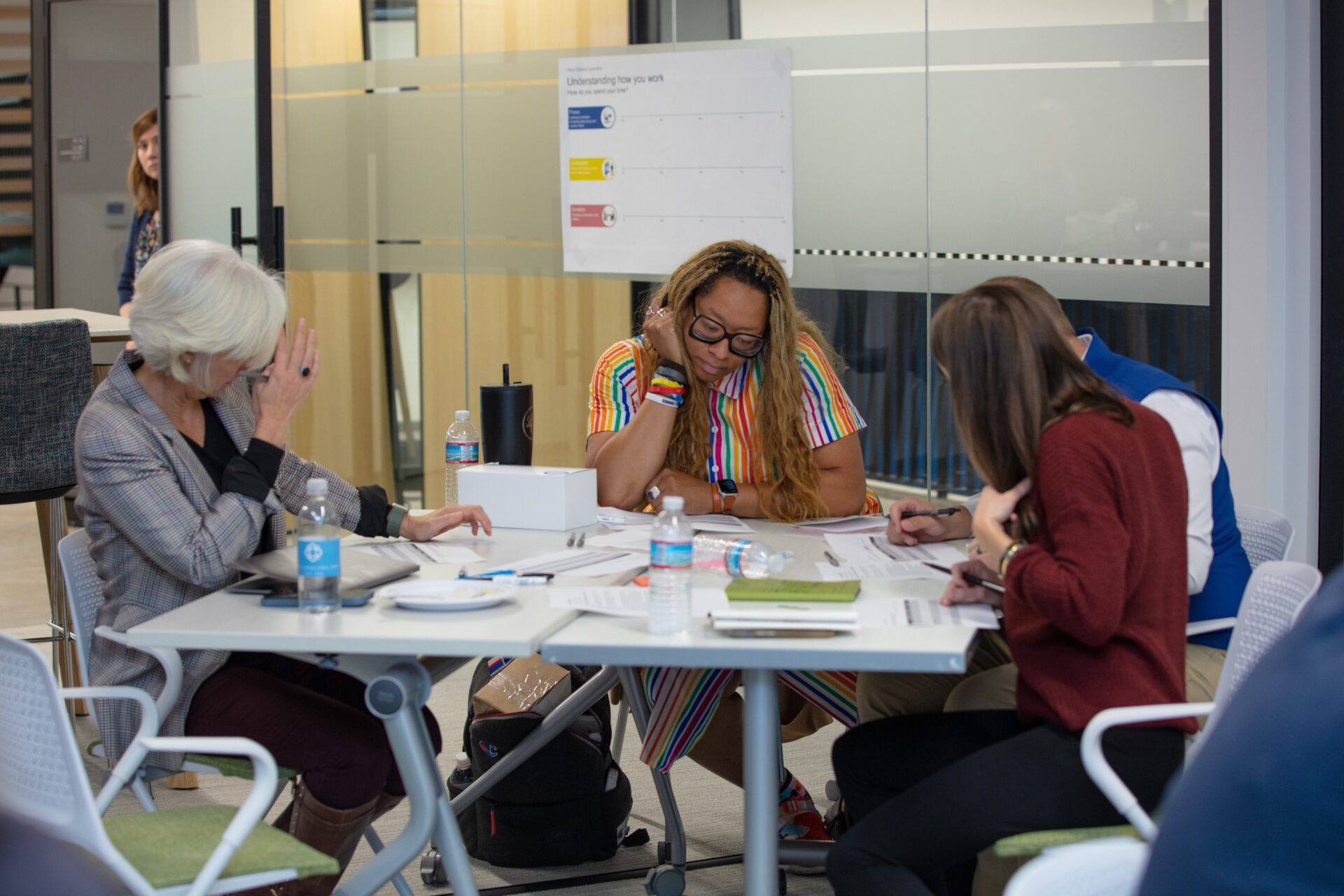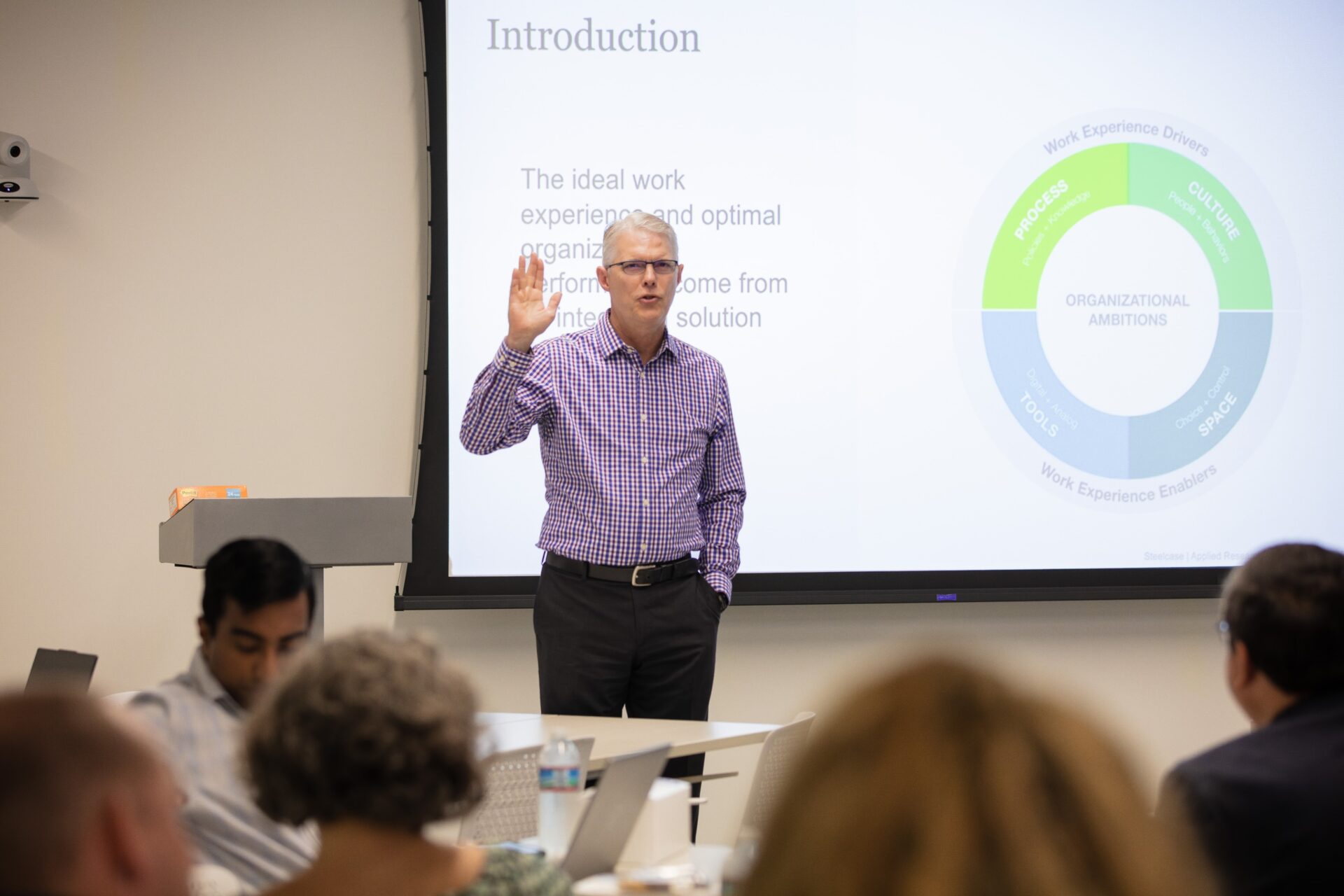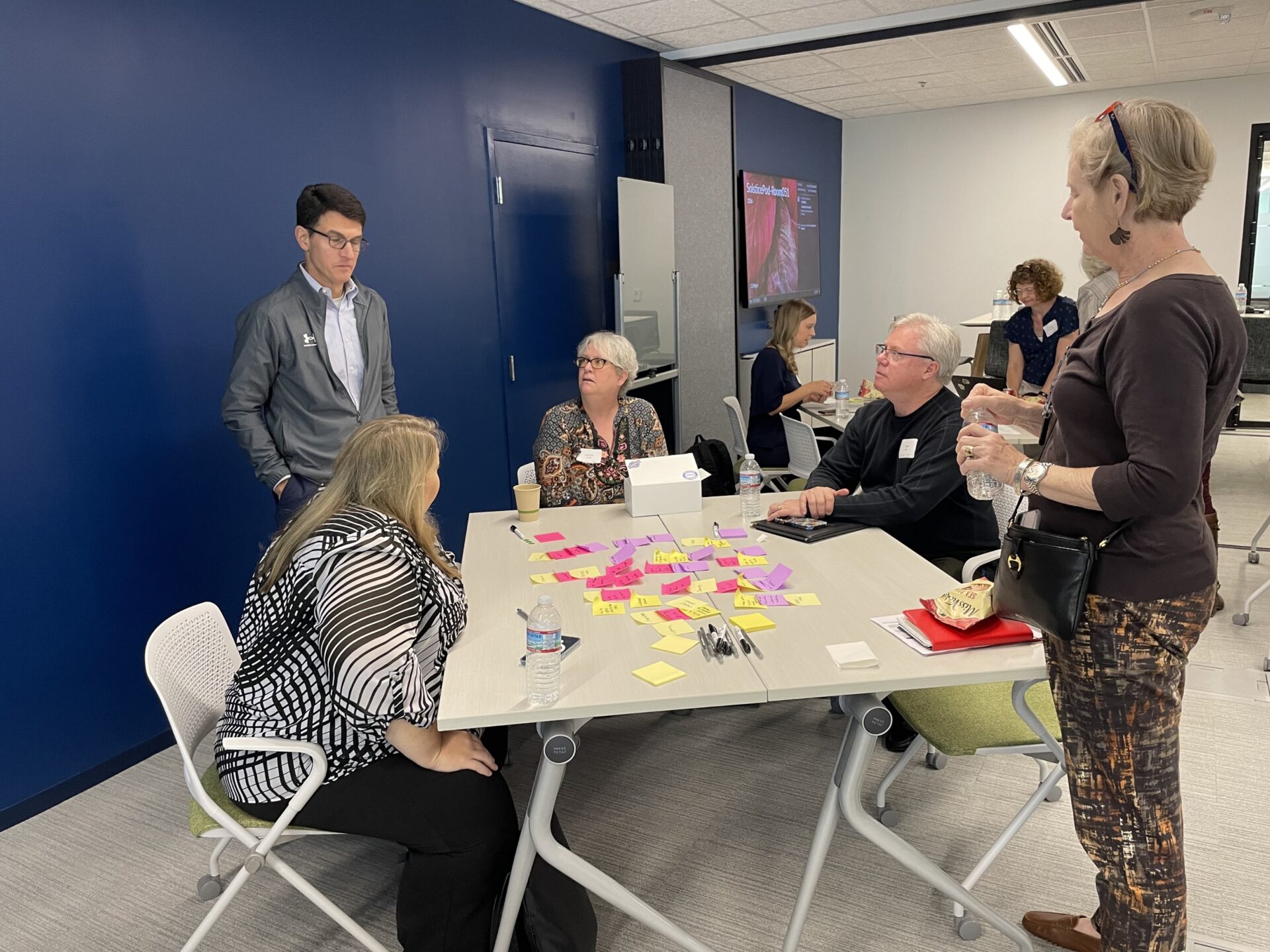

How do our notions of pre-COVID work life—in-person meetings, conference rooms, team lunches, and impromptu breakroom banter—fit with the remote video calls, flex schedules and at-home arrangements that became staples of the pandemic era? Experts from Steelcase and UNC-Chapel Hill’s Innovate Carolina share advice for leaders who want to blend the two work worlds into hybrid models that allow their organizations to operate smarter than ever.

We’re a long way from 2019. Yet, to some employees whose organizations are making swift 180-degree turns back to pre-pandemic work expectations that include coming to the office every day, it might not feel that way. In contrast, other employees feel like they’re stuck in a COVID-induced time capsule: they’re still working completely remote even though they want to spend more time in the office collaborating with others. With the pandemic easing, what degree of “going back” makes sense? How should our work environments—and the ways we interact—shift in the future? How might hybrid work as a happy medium?
According to a group of workplace strategists from Steelcase and design thinking experts from UNC-Chapel Hill, creating modern work environments isn’t a one-size-fits-all answer—but it’s a critical issue that most organizations need to figure out. The experts joined other University and industry leaders for a recent Signature Series workshop at the Innovate Carolina Junction, where they dove into what it takes for organizations to find the right work-model fit for the future. The Junction opened in downtown Chapel Hill late September as the University’s new innovation hub and home to Innovate Carolina, UNC-Chapel Hill’s central team for innovation, entrepreneurship and economic development. The fall event series explores how workplace trends, technologies and talent will shape how people and organizations work in the years ahead—a shift known as the future of work.
Hybrid work, a model in which people work in the office part of the time and from another location part of the time, has become a hot topic in recent years. However, contrary to common perception, hybrid work isn’t a new phenomenon that arose alongside the COVID-19 pandemic, said John Hughes, principal of Steelcase Applied Research & Consulting, the company’s workplace consulting practice. “People might say that hybrid is new, but the topic of distributed working was first written about 40 years ago,” he said. “Companies have been implementing hybrid for three decades.”
Which emerging technologies, talent issues and trends do you need to understand to prepare for the professional world of tomorrow? Register to attend a Signature Series event at the Innovate Carolina Junction.
Attend the Signature Series
Hughes pointed out that, despite many American organizations adopting hybrid strategies, the U.S. is nearly 20 years behind countries like the United Kingdom, the Netherlands and Australia in implementing hybrid work. The ramp up curve in the U.S. has been short and steep, Hughes noted, saying that during the two decades preceding the pandemic, only roughly 10 to 12% of organizations—often industry leaders in innovation and performance—implemented hybrid work. Over the past five years, however, upwards of 70% of organizations have indicated they want to implement hybrid. This short runway is crowded by many hybrid newbies, which creates an experience gap: a lot of organizations now want to rapidly implement hybrid work, but there aren’t many who have done so effectively already and are able to provide proven advice. However, Hughes said that research and Steelcase’s extensive work with clients indicates that the effort is usually worth the lift: successful implementation of hybrid work positively impacts the employee experience and organizational effectiveness.
Here are four tips from the workshop for finding a hybrid solution that works for your organization:
While many organizations focus on physical space and the degree to which it is filled with employees, Hughes recommended that leaders take a more integrated view. “One of the things we’ve learned by working with organizations for over 20 years is that hybrid is about much more than space,” he said. “For an effective hybrid solution, you need to be clear about what your organization is trying to accomplish: What are you ambitions? Who are you trying to be? What is your call?”
He suggested considering several dynamics, including organizational culture, processes, technological tools, and spaces. For instance, hybrid models require leaders to lead in new ways, understand new behaviors, and learn how to set expectations for being in the office. “A lot of organizations handle these expectations by simply saying you need to be in the office three or four days a week, but that’s probably not the best way to do it,” said Hughes. “Usually, identifying which behavior patterns are best suited to in-office work and trusting people to do the right thing produces the best outcomes.” He also noted that when people aren’t in the office as much, organizations should consider updating business processes and technologies, needs that often go unrecognized.

Ultimately, Hughes said that there are three success factors which, if implemented well, result in hybrid solutions that work well for employees and boost organizational performance: defining a workplace that fits the organization’s purpose, establishing change management, and ensuring executive sponsorship. “A number of CEOs tell their employees that they’re expected to be in the office at least three days a week, but what do you think the result is?” asked Hughes, who said that on a global scale, employees only end up working about two-thirds the amount of time onsite as their executives mandate. “Leaders need help understanding how to set expectations and how to help employees understand the value of being in the office. Some leaders are then doing something completely different themselves, which leads to problems. Leaders have to sponsor hybrid work and live the way they’re asking their people to live.”
Although the media often presents hybrid work as a singular concept, Hughes said it’s really a continuum—one that offers many options between a 100% in-office presence and a 100% remote presence. “Hybrid is a massive continuum, and the point that you choose on that continuum has a unique impact on the experience of people, the effectiveness of the organization, and a real-estate footprint size,” he said. “Too often, an organization stumbles into a hybrid solution and struggles to implement it. They simply didn’t realize that if they’d taken one step to the left or right on the continuum, they would have had a far better outcome.”
To identify precisely where on the in-person/remote continuum your organization should fall, Hughes organizations should identify their foundational pillars—important aspects of their business and culture—and quantitatively evaluate and score those pillars as relative priorities. In doing so, leaders will discover multiple scenarios for optimizing one part of the business over another, giving them the opportunity to make challenging, but necessary trade-off decisions. For instance, one organization may lean further toward remote work on the continuum, choosing to prioritize employee flexibility in choosing their work locations over community building and connections. Another organization with a high number of new employees and trainees might veer closer to the in-person side of the continuum, choosing to prioritize learning and development over employee flexibility.
How much time do you spend each day responding to emails? How about analyzing data, writing, or performing research? Do you spend more time meeting with colleagues to reviewing projects or solving problems together? Or what about simply catching up with teammates on a more personal basis?
Georgia Rappole, a client business manager at Steelcase, asked workshop participants to begin thinking in these terms and to reflect on their own work activity across three primary modes of work—an exercise that’s useful for individuals and organizations to explore when considering hybrid options.
“How much time do you spend focusing, collaborating with others and socializing?” she asked. “Think about your typical work cycle and what percentage of your time you spend in each of the work modes—it often depends on your job role and how you approach it.”
One group of workshop participants found that up to 90% of their workdays were filled with a mix of focused and collaborative work, while they spent only 10% socializing. Another found a more even distribution. “Work mode patterns are influenced by one’s individual role, preferred work style, and level within the organization,” said Rappole. “We all approach our work differently, so the technologies, tools, processes and spaces that support these work modes need to be diverse.”
One way leaders can begin solving hybrid work challenges—along with a wide range of other complex, multi-layered problems—is design thinking. During the workshop, leaders from Innovate Carolina’s Office of Design and Innovation for the Public Good (DIPG) worked with participants to use human-centered design thinking tools to build an understanding of the different modes of work that occur in their own organizations.
According to Liz Chen, PhD, MPH, assistant professor at the Gillings School of Global Public Health and Innovate Carolina design thinking lead who helped facilitate the workshop, design thinking is a problem-solving approach that deals with real human wants and needs. It helps problem solvers start with end-users in mind so they can create more effective solutions—everything from products and services to new initiatives like hybrid work models—before they sink too much time or money into options that won’t work.

“Design thinking elevates us and holds us accountable to the desirability, feasibility and viability of our idea,” said Chen. “Do people want the solutions you’re trying to create? Do we have the technological or financial resources to stand up a solution? Can your solution self-sustain after investments go away?” Innovate Carolina’s DIPG team, led by Bill Romani, PT, PhD, provides design thinking and innovation consultation, coaching and execution support to faculty, staff and students—and a wide range of businesses, government agencies and nonprofits outside the University—helping them build more effective products, services and outcomes. To do so, it uses a variety of tools, two of which Chen introduced to workshop attendees: journey maps and brainstorming.
Chen guided workshop participants on how to create a journey map for a single job role—a project coordinator—that focused on one of the three targeted modes of work: focus, collaborate and socialize. Participants worked in groups and reflected on questions like: What do project coordinators do at the beginning, middle and end of their workdays? Where do they work? What activities or behaviors are they engaged in? How might they feel? And what distractions might they face?
“A journey map is a visual tool that allows you to identify key moments in the product, service or experience you’re designing. It can track or show decisions, behaviors or feelings,” said Chen. “It would be great if leaders could use tools like journey maps to think through the type of tasks each type position does in order to inform their decision about where on the hybrid spectrum their organization should be.”
Chen also helped the group apply a widely familiar tool—brainstorming—in new ways. Workshop participants reported that when brainstorming in the past, they haven’t had enough time to generate ideas, or they became frustrated with fellow brainstormers who moved too quickly from the idea-generation phase into decision-making mode. Chen offered several recommendations for making brainstorming work better. Before a group session, Chen said it’s helpful to preview the topic with the group and dedicate time for individual brainstorming. She also advocated for smart uses of technology that will save you time taking notes or that help keep ideas anonymous. She also emphasized the importance of separating brainstorming activities (divergent thinking) from decision-making activities (convergent thinking) whenever possible.
She asked groups at the workshop to spend several minutes brainstorming answers to how-might-we questions about hybrid work modes and locations. For example: How might we optimize the home/in-office setting for focused/collaboration/socialization tasks? In doing so, she asked participants to adhere to IDEO’s rules of brainstorming:
The goal was to generate as many ideas as possible and to then share the wildest possibilities. So, what kinds of ideas did the teams come up with in a matter of minutes?
Want to explore your own hybrid work or design thinking project?
Contact the Steelcase Applied Research and Consulting team to begin reimagining your employee work experience, or the Innovate Carolina Office of Design and Innovation for the Public Good to get started with human-centered tools that you can use to turn your ideas into economic and community benefit.